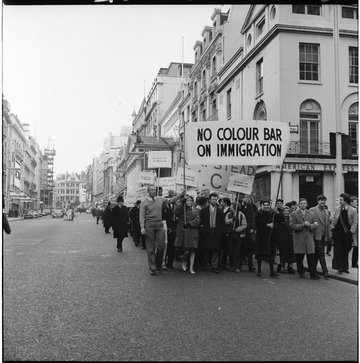
Protest and Resistance
South Asians in Britain resisted discrimination and economic exploitation through collective action and solidarities with anti-racist organizations, from the nineteenth century onwards
Overview
South Asians have played a critical role in resisting injustices such as racism, colonialism and labour exploitation since the nineteenth century. Lawyer and activist Shyamaji Krishnavarma, who migrated to Britain in 1879, founded India House in Highgate, London in 1905, which became a meeting-place for Indian revolutionaries. In 1916 feminist and politician Annie Besant founded the Home Rule for India League, which lobbied for Indian self-governance.
Other key figures, such as the Methodist minister Kamal Athon Chunchie, who founded the Coloured Men’s Institute in Canning Town, worked to improve the lives of racialized minority groups residing in the dock districts of London. In addition, the Indian Seamen’s Welfare League, co-founded by activists Ayub Ali and Shah Abdul Majid Qureshi in 1943, advocated for the social welfare of destitute seamen. This type of organizing became important given the enactment of discriminatory legislation such as the 1919 Aliens Restriction Act, as well as events such as the 1919 Race Riots.
By the early twentieth century, protest and resistance movements against British imperialism became a focal point for South Asian networking. Organizations such as the India League, founded by activist and politician Krishna Menon, were established to mobilize British people against the injustices of British imperialism. The Indian Workers’ Association also advocated for Indian independence and became an important site for South Asian workers’ rights campaigning.
The growing presence of South Asian migrants following the enactment of the Commonwealth Immigrants Act of 1962 was met with hostility. By the 1970s, when Britain was experiencing recession, the National Front, a far-right organization, argued that immigration was to blame for the country’s economic plight. Membership grew rapidly, particularly in 1972 when the expulsion of South Asians from Uganda instigated debates about immigration and citizenship.
There were political attempts to curb racial discrimination. For example, the Race Relations Act of 1965 made discrimination illegal, a cause which the Campaign Against Racial Discrimination (CARD) advocated for. However, the legislation had limited scope. Collective action, therefore, was necessary to instigate political change. During the 1964 general election, physician and Labour councillor Dr Prem Dhani challenged Conservative MP Enoch Powell on his discriminatory views. By the late 1970s, the Asian Youth Movement (AYM) began in Southall and inspired collective action in places such as Bradford, Manchester and Burnley, where movements in support of the Bradford 12 and anti-deportation activist Anwar Ditta grew.
Another interesting thing
In response to the emergence of Black Power in the US, as well as anti-racist activist Stokely Carmichael’s visit to London in 1967, the British Black Power movement gained traction by advocating for the self-determination of Black people. Radical Black Power groups such as the British Black Panthers – which adopted the ideology of ‘political Blackness’ - attracted South Asian activists such as Mala Sen and Farrukh Dhondy, who were members of the Race Today Collective, as well as Roy Sawh, who was a leading member of the Universal Coloured People’s Association. Jagmohan Joshi, who founded the Birmingham branch of the Indian Workers’ Association with Avtar Singh Jouhl, founded the Black People’s Alliance, an anti-racist umbrella organization which advocated for radical and militant action.
Browse this theme
Image credit
A demonstration against the Colour Bar Immigration Bill, Trafalgar Square, by Henry Grant, HG2123/5, © Henry Grant Collection/London Museum, https://creativecommons.org/licenses/by-nc/4.0/
